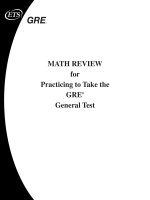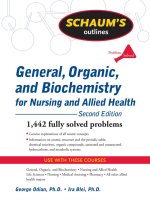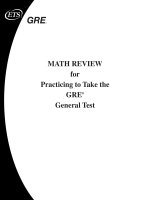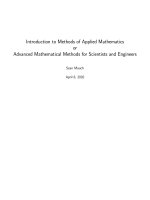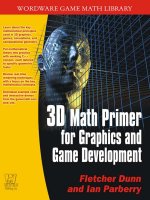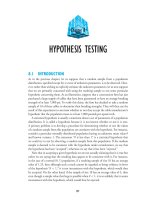Ebook Davis’s basic math review for nursing and health professions (2/E): Part 2
Bạn đang xem bản rút gọn của tài liệu. Xem và tải ngay bản đầy đủ của tài liệu tại đây (32.98 MB, 176 trang )
Section 6.4
13. 9n − 15 = 6n
14. 4x − 9 = 7x − 12
15. 6y − 3 = 3(y + 2)
16. 5m − 2m + 4 = 3m + m − 1
17. 5(3x + 6) = 3(x + 18)
18. −4x − 3 + 2x − 6 = −7x + 6
19. x − 5 + 4x = 4(x − 3)
20. 2(y + 8) − 4 = 8y
166
part 1 Basic Math Skills
2056_06_137-166.indd 166
11/5/09 11:50:57 AM
part
Practice Tests for
Basic Math Skills
II
Practice Test 1
Cumulative Skills Test
This test provides sample problems for each math skill presented in Part I.
The test will show you which skills you have mastered as well as help you
identify any skills for which you need additional practice.
Solve each problem.
For test answers, see “Step-by-Step Solutions,” pages 288-294. To the left of
each solution, you will notice two numbers. These numbers indicate the
chapter and section—for example, (1.2) means Chapter 1, Section 2—where
you can find a detailed explanation for solving similar problems. If your
answer is incorrect and you need more practice, you may wish to review the
indicated material.
1.
57,942
+ 78,859
2.
21,300
− 17,452
3. 4,706
× 505
4. Write the quotient with a remainder.
)
530 25,075
167
2056_Pt2_test_167-174.indd 167
11/5/09 11:55:01 AM
5. Write in fraction form.
39
6. Write as a mixed number.
36
5
7. Write as an improper fraction.
2
3
5
8. Are these fractions equivalent?
1
9
=
3
27
9. 4 ×
10. 4
7
9
3
1
5
× 2 × 1
5
2
23
11.
5
25
÷
8
16
12.
3
÷ 2
7
13. 4
4
8
÷
5
3
14. Find the least common denominator for these fractions.
3
1
and
7
4
15. Find the least common denominator for these fractions.
5
8
and
21
35
16. Find the least common denominator for these fractions.
7
11
5
and
and
15
12
8
17. 2
18.
168
3
1
2
+
+ 6
5
3
15
53
19
−
88
44
part II Practice Tests for Basic Math Skills
2056_Pt2_test_167-174.indd 168
11/5/09 11:55:05 AM
19. 26
1
5
− 5
4
6
20. Which digit is in the thousandth’s place?
14.6597
21. Write
67
as a decimal number.
10,000
22. Write the decimal number two hundred six ten thousandths.
23. Round 346.785 to the nearest hundredth.
24. Round 87,943 to the nearest ten.
25. 4.23 + 1.5 + 7.2341
26. 23.479 − 0.96
27. 0.171 × 0.238
28. 0.6 ÷ 0.02
29. Round the quotient to the nearest tenth.
)
24 539
30. Write 0.25 as a reduced fraction.
31. Write
3
as a decimal number.
4
32. Arrange from least to greatest.
0.2 0.02 0.3 0.33
33. Place <, =, or > in the blank.
1
0.27 ______
5
34. Arrange from least to greatest.
3
7
11
5 15
30
Practice Test 1
2056_Pt2_test_167-174.indd 169
Cumulative Skills Test
169
11/5/09 11:55:06 AM
35.
25
n
=
4
12
36. 40 is what percent of 16?
37. 30% of 90 is what?
38. 50 is 20% of what?
1
39. 12 % of what is 15?
2
40.
3
3
is what percent of ?
16
4
41. Write 12.5% as a fraction.
42. Write
6
as a percent.
18
43. Write 6 : 20 as a percent.
44.
6.5
20%
45. Write 66% as a decimal.
46. Write 0.456 as a percent.
47. −17 + (−4)
48. 25 + (−8)
49. −36 + 36
50. −18 + 10
51. 13 − 15
52. −8 − 19
53. −5 − (−23)
54. 7 − (−4)
170
part II Practice Tests for Basic Math Skills
2056_Pt2_test_167-174.indd 170
11/5/09 11:55:06 AM
55. (−9)(−10)
56. 4(−17)
57.
−81
−9
58.
−15
60
59. 7x − 3x + 12x
60. 5xy2 − 3xy − xy
61. (x2 − 2) − (3x2 − 4x + 5)
62. 7(r + 6)
63. −3(x2 + 7x − 9)
64. − (a − 10)
65. x + 37 = −26
66. x − 71 = 23
67. −5x = −80
68.
2
x = −14
5
69. 3x + 7 = 22
70. 13 −
3x
= 37
2
71. 3x − 10 = −9x
72. 2(x + 1) = 3x − 1
73. 2(y + 3) = 4(y − 6)
74. 3(x + 3) + 5 = 2x
75. 13 + 5x − 7 = 3x − 8 − 12x
Practice Test 1
2056_Pt2_test_167-174.indd 171
Cumulative Skills Test
171
11/5/09 11:55:07 AM
Practice Test 2
Combined Skills Test
The Combined Skills Test contains problems that require the use of one or
more basic math skills. If you are preparing to take a timed, standardized
test, this test provides excellent practice.
Set a timer for 30 minutes (1 minute for each problem), write each problem on your paper and solve. Repeat this process until you are able to complete the test in 30 minutes with the desired accuracy.
Table 11:
Score Results
Number Incorrect
Score
0-3
4-6
7-9
A
B
C
For test answers, see “Step-by-Step Solutions,” pages 295-298. To the left
of each solution, you will notice two numbers. These numbers indicate the
chapter and section—for example, (1.2) means Chapter 1, Section 2—where
you can find a detailed explanation for solving similar problems. If your
answer is incorrect and you need more practice, you may wish to review the
indicated material.
1. Write
47
as a decimal number.
100,000
2. Which digit is in the hundredth’s place?
1,346.979
3. Write the decimal number sixteen and four hundredths.
4. Round 5,642.0182 to the nearest thousandth.
5. 9.6 + 8.234 + 1.05
6. 403.1 − 15.236
7. 14.56 × 0.2
8. 0.903 ÷ 0.43
172
part II Practice Tests for Basic Math Skills
2056_Pt2_test_167-174.indd 172
11/5/09 11:55:07 AM
9. Reduce to lowest terms.
25
300
10. Write as a mixed number.
50
7
11. Are these fractions equivalent?
2
8
=
5
25
1
5
1
12. 1 + 2 +
4
6
12
13. 37
1
4
− 9
5
7
3
2
4
14. 1 × 2 × 1
4
3
5
15.
5
1
÷ 1
9
3
16. Write 62.5% as a reduced common fraction.
17. Write
1
as a decimal number.
8
18. Write 650% as a decimal.
19. Write
49
as a percent.
7
20. Write 4 : 20 as a percent.
21. Write 0.017 as a percent.
22.
13.4
40%
23. 16.5% of 72 is what?
24. 33
1
% of x is 45?
3
Practice Test 2
2056_Pt2_test_167-174.indd 173
Combined Skills Test 173
11/5/09 11:55:07 AM
25. 210 is 35% of what?
26.
1
4
is what percent of ?
2
5
27. (x2 − 5) − (−4x2 + 5x − 1)
28. −2v + 4 = −8
29. 5m + 8 = 3(m + 4)
30. 4(x − 9) + 12 = −2(x − 6)
31. Arrange from least to greatest.
0.57 0.507 0.572 0.5
32. Place <, =, or > in the blank.
3
0.35 ______
8
33. Arrange from least to greatest.
1
1
1
8
4
6
174
part II Practice Tests for Basic Math Skills
2056_Pt2_test_167-174.indd 174
11/5/09 11:55:08 AM
Measures Used
in Health Care
Applications
chapter
part
III
7
Household Measures
7.0
7.1
7.2
7.3
7.4
Pretest for Household Measures
Household Measures for Length
Household Measures for Weight
Household Measures for Volume
Chapter Test for Household Measures
7.0
Pretest for Household Measures
Solve the following problems. After taking the test, see “Step-by-Step Solutions” for the answers (page 299). Then, see “7.1 Household Measures for
Length,” “7.2 Household Measures for Weight,” and “7.3 Household Measures
for Volume” for skill explanations.
Sections 7.1 and 7.2
Convert the following measurements.
1. 40 ounces to pounds
7. 5,000 pounds to tons
2. 4 feet to inches
8. 17 miles to feet
3. 3 pints to quarts
4. 15 teaspoons to tablespoons
5. 25 feet to yards
Section 7.3
9. 3 cups to tablespoons
10. 8 pints to gallons
6. 6 tablespoons to fluid ounces
175
5659_07_175-190.indd 175
15/11/16 11:59 AM
7.1
Household Measures for Length
In this section, we will review:
• converting measurements using unit
multipliers
• length conversions
Converting Measurements Using Unit Multipliers
Unit multipliers are helpful for making conversions in any measurement
system. They are used in some nursing calculations. A unit multiplier is
written in fraction form and has a value of 1 if reduced. What makes these
fractions unique is that unit multipliers include units of measure along
with numbers. For example:
12 inches = 1 foot
12 inches
1 foot
12 inches
=1
1 foot
is a unit multiplier.
Multiplying by a unit multiplier, a carefully chosen form of 1, is the key to
converting units. Unit multipliers work because you can multiply any
number by 1 and not change its value.
Using a Unit Multiplier
To solve a conversion problem by using a unit multiplier, follow these four
steps:
1. Write the number and unit given in fraction form.
2. Find the unit multipliers in the chart that contain both units in
the problem.
3. Choose the unit multiplier that has the unit you are solving for in
the numerator.
4. Multiply the fraction form in step 1 by the chosen unit multiplier. Cross cancel numbers and units. Reduce if necessary. Be
sure the answer is written in best mathematical form.
176
part III Measures Used in Health Care Applications
5659_07_175-190.indd 176
15/11/16 12:00 PM
Table 7.1
Unit Multipliers for Length
Length Conversions
Unit Multipliers
12 inches = 1 foot
3 feet = 1 yard
5,280 feet = 1 mile
Length Conversions
The most common units for household length are the inch, foot, yard, and
mile. See Table 7.1 for common conversions and the corresponding unit
multipliers. Note that each conversion has two corresponding unit multipliers, which are reciprocals.
Example 1:
Convert 6 inches to feet.
6 in.
1
STEP 1. Write 6 inches in fraction form.
STEP 2. Find the unit multipliers in the chart that
contain both inches and feet.
12 in.
1 ft.
or
1 ft.
12 in.
STEP 3. Choose the unit multiplier that has the unit
you are solving for (feet) in the numerator.
1 ft.
12 in.
STEP 4. Multiply the fraction form in STEP 1 by the
chosen unit multiplier. Cross cancel numbers
and units. Reduce if necessary. Write the
answer in best form.
1
The answer is
1
foot.
2
6 in . 1 ft.
1 ft. 1
= foot
i
=
1 2 12 in .
2
2
chapter 7
5659_07_175-190.indd 177
Household Measures
177
15/11/16 12:00 PM
Example 2: Convert 243 feet to yards.
STEP 1. Write 243 feet in fraction form.
243 ft.
1
STEP 2. Find the unit multipliers in the chart that
contain both feet and yards.
3 ft.
1 yd.
or
1 yd.
3 ft.
STEP 3. Choose the unit multiplier that has the unit
you are solving for (yards) in the numerator.
1 yd.
3 ft.
STEP 4. Multiply the fraction form in STEP 1 by the
chosen unit multiplier. Cross cancel numbers
and units. Reduce if necessary. Write the
answer in best form.
81
243 ft . 1 yd. 81 yd.
i
=
= 81 yards
1
1
t
.
3
f
1
The answer is 81 yards.
Example 3:
Convert 26,400 feet to miles.
STEP 1. Write 26,400 feet in fraction form.
26,400 ft.
1
STEP 2. Find the unit multipliers in the
chart that contain both feet
and miles.
5,280 ft.
1 mi.
or
1 mi.
5,280 ft.
STEP 3. Choose the unit multiplier that
has the unit you are solving for
(miles) in the numerator.
1 mi.
5,280 ft.
178
part III Measures Used in Health Care Applications
5659_07_175-190.indd 178
15/11/16 12:00 PM
STEP 4. Multiply the fraction form in STEP 1 by the
chosen unit multiplier. Cross cancel numbers
and units. Reduce if necessary. Write the
answer in best form.
5
26,400 ft.
1 mi.
5 mi.
i
=
= 5 miles
1
1
,
5
280
ft
.
1
The answer is 5 miles.
7.1 Practice Household Measures for Length Conversions
Convert the following measurements using a unit multiplier. For the answers, see “Step-by-Step
Solutions” (pages 300 to 301).
1. 9 feet to inches
11. 720 yards to feet
2. 72 inches to feet
12. 7,920 feet to miles
3. 4 miles to feet
13. 30 feet to inches
4. 6 feet to yards
14. 693 feet to yards
5. 9,240 feet to miles
15. 30 inches to feet
6. 430 feet to yards
16. 10 miles to feet
7. 120 inches to feet
17. 27,720 feet to miles
8. 18 miles to feet
18. 29 yards to feet
9. 42 feet to inches
19. 10 feet to yards
10. 33 feet to yards
20. 1.25 miles to feet
chapter 7
5659_07_175-190.indd 179
Household Measures
179
15/11/16 12:00 PM
7.2
Household Measures for Weight
In this section, we will review:
• using a unit multiplier
• weight conversions
Using a Unit Multiplier
To use a unit multiplier, follow the steps listed in Section 7.1 Household
Measures for Length, page 176.
Tip: All types of conversion problems—length, weight, or volume—that
require one unit multiplier can be solved by applying the four steps for
using a unit multiplier.
Weight Conversions
The most common units for household weight are the ounce, pound, and
ton. See Table 7.2 for common conversions and the corresponding unit
multipliers. Note that each conversion has two corresponding unit multipliers, which are reciprocals.
Table 7.2
Unit Multipliers for Weight
Weight Conversions
Unit Multipliers
16 ounces = 1 pound
16 oz.
1 lb.
or
1 lb.
16 oz.
2,000 pounds = 1 ton
2,000 lbs.
1 ton
or
1 ton
2,000 lbs.
If the conversion contains a fraction, change it to decimal form before
solving. For example:
1
180
1
pounds = 1.5 pounds
2
part III Measures Used in Health Care Applications
5659_07_175-190.indd 180
15/11/16 12:00 PM
Example 1: Convert 72 ounces to pounds.
STEP 1. Write 72 ounces in fraction form.
72 oz.
1
STEP 2. Find the unit multipliers in the chart that
contain both ounces and pounds.
16 oz.
1 lb.
or
1 lb.
16 oz.
STEP 3. Choose the unit multiplier that has the unit
you are solving for (pounds) in the
numerator.
1 lb.
16 oz.
STEP 4. Multiply the fraction form in STEP 1 by the
chosen unit multiplier. Cross cancel numbers
and units. Reduce if necessary. Write the
answer in best form.
9
72 oz .
1
1 lb.
9
1
= lbs. = 4 pounds
2
16 oz . 2
2
i
The answer is 4½ pounds.
Example 2:
Convert 6,800 pounds to tons.
STEP 1. Write 6,800 pounds in fraction
form.
6,800 lb.
1
STEP 2. Find the unit multipliers in the
chart that contain both pounds
and tons.
2,000 lb.
1 ton
or
1 ton
2,000 lb.
STEP 3. Choose the unit multiplier that has
the unit you are solving for (tons)
in the numerator.
1 ton
2,000 lb.
chapter 7
5659_07_175-190.indd 181
Household Measures
181
15/11/16 12:00 PM
STEP 4. Multiply the fraction form in STEP 1 by the
chosen unit multiplier. Cross cancel numbers
and units. Reduce if necessary. Write the
answer in best form.
17
34
68
6,800 lb .
2
1 ton
17 tons
=
= 3 tons
i
5
1
5
2,000 lb .
20
5
The answer is 3
Example 3:
10
2
tons.
5
Convert 2
3
pounds to ounces.
4
3
to a decimal number.
4
Write 2.75 pounds in fraction form.
STEP 1. Change 2
2.75 lb.
1
STEP 2. Find the unit multipliers in the chart that
contain both pounds and ounces.
16 oz.
1 lb.
or
1 lb.
16 oz.
STEP 3. Choose the unit multiplier that has the unit
you are solving for (ounces) in the
numerator.
16 oz.
1 lb.
STEP 4. Multiply the fraction form in STEP 1 by the
chosen unit multiplier. Cross cancel numbers
and units. Reduce if necessary. Write the
answer in best form.
2.75 lb. 16 oz.
i
= 44 ounces
1
1lb.
The answer is 44 ounces.
182
part III Measures Used in Health Care Applications
5659_07_175-190.indd 182
15/11/16 12:00 PM
7.2 Practice Weight Conversions
Convert the following measurements using a unit multiplier. For the answers, see “Step-by-Step
Solutions” (pages 301 to 303).
1. 32 ounces to pounds
11. 4 tons to pounds
2. 3 pounds to ounces
12. 20,000 pounds to tons
3. 2.5 tons to pounds
13. 144 ounces to pounds
4. 2,500 pounds to tons
14. 15,000 pounds to tons
5. 5
6.
1
pounds to ounces
4
3
ton to pounds
4
15. 16 ounces to pounds
16. 1
1
tons to pounds
2
7. 12 ounces to pounds
17. 112 ounces to pounds
8. 3,600 pounds to tons
18. 1,000 pounds to tons
9. 68 ounces to pounds
19. 16 tons to pounds
10. 1
1
pounds to ounces
4
20. 5.5 pounds to ounces
chapter 7
5659_07_175-190.indd 183
Household Measures
183
15/11/16 12:00 PM
7.3
Household Measures for Volume
In this section, we will review:
• using two unit multipliers in a conversion
• volume conversions
Using Two Unit Multipliers in a Conversion
For the length and weight conversions shown thus far, only one unit multiplier was required to find the answer. However, some conversions may
require more than one unit multiplier. For instance, when no unit multiplier in Table 7.3 shows a direct conversion between units, you will need
two or more unit multipliers to link the units to reach the desired unit.
This is the way to think through the conversion process:
• Three terms are multiplied together to find the answer.
• The first term is the number and unit given in the problem written
in fraction form.
• The second term is the first unit multiplier. It has the same denominator as the unit given in the first term.
• The third term is the second unit multiplier. It has the units you
are trying to find in the numerator.
Volume Conversions
Volume means capacity, or how much something holds. Within the household measurement system, there are many measures and a variety of conversions for volume. See Table 7.3 for the conversions and the corresponding
unit multipliers for volume.
Some volume conversions require only one unit multiplier. However, in
this section there is no direction conversion shown in the table for the
units given in the examples. Therefore, two unit multipliers will be
required to complete the conversions.
184
part III Measures Used in Health Care Applications
5659_07_175-190.indd 184
15/11/16 12:00 PM
Table 7.3
Unit Multipliers for Volume
Measure
Volume Conversions
Unit Multipliers
tablespoon
1 tablespoon = 3 teaspoons
1 T.
3 tsp.
or
3 tsp.
1 T.
fluid ounce
1 fluid ounce = 2 tablespoons
1 fl.oz.
2 T.
or
2 T.
1 fl.oz.
cup
1 cup = 8 fluid ounces
1 cup
8 fl.oz.
or
8 fl.oz.
1 cup
pint
1 pint = 2 cups
1 pt.
2 cups
or
2 cups
1 pt.
quart
1 quart = 2 pints
1 qt.
2 pt.
or
2 pt.
1 qt.
gallon
1 gallon = 4 quarts
1 gal.
4 qt.
or
4 qt.
1 gal.
Example 1:
Convert 12 gallons to pints. Use 2 unit multipliers.
12 gal.
pt.
i
i
1
gal.
STEP 1. Write a 3-term format to begin.
First, write 12 gallons in fraction
form. The second term has gallons
in the denominator in order to cancel
with the numerator in the first term.
The third term has the units you are
trying to find (pints) in the numerator.
STEP 2. Find a unit multiplier in the
conversion chart with gallon
in the denominator.
4 qt.
1 gal.
STEP 3. Place this unit multiplier in the
second term.
12 gal . 4 qt. pt.
i
i
1
1 gal.
2 pt.
1 qt.
STEP 4. Observe that the third term must
have quart in the denominator to
cancel with the quart in the
numerator in the second term.
Look at the chart and choose the
unit multiplier with pint in the numerator
and quart in the denominator.
chapter 7
5659_07_175-190.indd 185
Household Measures
185
15/11/16 12:00 PM
STEP 5. Place this unit multiplier in the
third term.
12 gal . 4 qt. 2 pt.
i
i
1
1 gal. 1 qt.
STEP 6. Cross cancel numbers and units. Multiply
remaining numerators and denominators.
Reduce if necessary. Write the answer in
best form.
12 gal. 4 qt. 2 pt.
i
i
= 96 pint s
1
1 gal. 1 qt.
The answer is 96 pints.
Example 2:
Convert 2 cups to tablespoons. Use 2 unit multipliers.
2 cups
STEP 1. Write a 3-term format to begin.
First, write 2 cups in fraction form.
The second term has cup in the
denominator in order to cancel with
the numerator in the first term. The third
term has the units you are trying to find
(tablespoons) in the numerator.
1
STEP 2. Find a unit multiplier in the
conversion chart with cup in the
denominator.
8 fl. oz.
1 cup
STEP 3. Place this unit multiplier in the
second term.
2 cups
1
STEP 4. Observe that the third term
must have fluid ounces in the
denominator to cancel with the
fluid ounces in the numerator in
the second term. Look at the chart
and choose the unit multiplier with
tablespoon in the numerator and
fluid ounces in the denominator.
186
i
i
cup
i
T.
8 fl. oz . T.
i
1 cup
2 T.
1 fl. oz.
part III Measures Used in Health Care Applications
5659_07_175-190.indd 186
15/11/16 12:00 PM
2 cups
STEP 5. Place this unit multiplier
in the third term.
1
i
8 fl.oz.
2 T.
i
1 cup 1 fl.oz.
STEP 6. Cross cancel numbers and units. Multiply
remaining numerators and denominators.
Reduce if necessary. Write the answer in
best form.
2 cups
1
i
8 fl.oz.
1 cup
i
2 T.
= 32 tablespoons
1 fl.oz.
The answer is 32 tablespoons.
Example 3:
Convert 100 cups to quarts. Use 2 unit multipliers.
qt.
100 cups
i
i
1
cups
STEP 1. Write a 3-term format to
begin. First, write 100 cups
in fraction form. The second
term has cups in the
denominator in order to cancel with the
numerator in the first term. The third term
has the units you are trying to find (quart) in
the numerator.
STEP 2. Find a unit multiplier in the
conversion chart with cups in
the denominator.
1 pt.
2 cups
STEP 3. Place this unit multiplier in
the second term.
100 cups 1 pt. qt.
i
i
1
2 cups
1 qt.
2 pt.
STEP 4. Observe that the third term
must have pint in the
denominator to cancel with
the pint in the numerator in
the second term. Look at the chart and
choose the unit multiplier with quart in the
numerator and pint in the denominator.
chapter 7
5659_07_175-190.indd 187
Household Measures
187
15/11/16 12:00 PM
STEP 5. Place this unit multiplier in
the third term.
100 cups 1 pt. 1 qt.
i
i
1
2 cups 2 pt.
STEP 6. Cross cancel numbers and units. Multiply
remaining numerators and denominators.
Reduce if necessary. Write the answer in
best form.
25
50
100 cups
1
1 pt.
1 qt.
= 25 quarts
pt.
2
cups
2
1
1
i
i
The answer is 25 quarts.
7.3 Practice Volume Conversions
Convert the following measurements using one unit multiplier. For the answers, see “Step-byStep Solutions” (pages 303 to 305).
1. 6 tablespoons to teaspoons
6. 6 gallons to quarts
2. 20 quarts to pints
7. 27 teaspoons to tablespoons
3. 4 gallons to quarts
8. 10 cups to pints
4. 45 pints to cups
9. 22 quarts to gallons
5. 12 fluid ounces to cups
10. 9 teaspoons to tablespoons
Use two unit multipliers from the chart to convert the following measurements.
1
cups to tablespoons
2
11. 26 tablespoons to cups
16. 1
12. 2 pints to fluid ounces
17. 32 fluid ounces to pints
13. 7 cups to quarts
18. 160 cups to quarts
14. 10 gallons to pints
19. 32 tablespoons to cups
15. 8 fluid ounces to pints
20. 3 quarts to cups
188
part III Measures Used in Health Care Applications
5659_07_175-190.indd 188
15/11/16 12:00 PM
7.4
Chapter Test for Household Measures
Solve the following problems. After taking the test, see “Step-by-Step Solutions” for the answers (pages 306 to 308). And see “7.1 Household Measures for Length,” “7.2 Household Measures for Weight,” and “7.3
Household Measures for Volume” if the chapter test indicates you need
additional practice.
Sections 7.1 and 7.2
Convert the following measurements using one unit multiplier.
1. 5 tablespoons to teaspoons
2. 20 inches to feet
3. 7
1
pints to cups
2
4. 7 tablespoons to fluid ounces
5. 18 teaspoons to tablespoons
6. 9 pints to quarts
7. 3.5 tons to pounds
8. 4.6 miles to feet
9. 14 fluid ounces to cups
10. 2,640 feet to miles
11. 3 fluid ounces to tablespoons
12. 6 quarts to gallons
13. 1.5 pounds to ounces
14. 81 feet to yards
chapter 7
5659_07_175-190.indd 189
Household Measures
189
15/11/16 12:00 PM
15. 4 fluid ounces to cups
16. 12 quarts to pints
17. 3
1
feet to inches
2
Section 7.3
Convert the following measurements using two unit multipliers.
18. 4 pints to fluid ounces
19. 2 cups to quarts
20. 2.5 fluid ounces to teaspoons
190
part III Measures Used in Health Care Applications
5659_07_175-190.indd 190
15/11/16 12:00 PM
